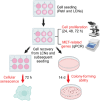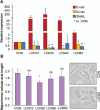Liquid Crystalline Networks Hamper the Malignancy of Cancer Cells
- PMID: 39828609
- PMCID: PMC11912096
- DOI: 10.1002/adhm.202403607
Liquid Crystalline Networks Hamper the Malignancy of Cancer Cells
Abstract
Mimicking compositions and structures of extracellular matrix is widely studied to create in vitro tumor models, to deepen the understanding of the pathogenesis of the different types of cancer, and to identify new therapies. On the other hand, the use of synthetic materials to modulate cancer cell biology and, possibly, to reduce the malignancy of cancer cells through their exploitation is far less explored. Here, the study evaluates the effects of Liquid Crystalline Networks (LCNs) based scaffolds on the growth of A375 metastatic melanoma cells. Interestingly, cells grown on such materials show reduced cell proliferation and colony-forming capacity with respect to those cultivated on standard plates. These effects are associated with a higher percentage of senescent cells and a shift to a more epithelial phenotype, pointing to the occurrence of a mesenchymal to epithelial transition. All these biological outcomes are affected by the amount of crosslinker in the material and have been induced only thanks to the interactions with the polymeric substrate without the need of further chemical (e.g., specific growth factor) or physical (e.g., irradiation) stimuli, opening to the possible development of anti-cancer coatings.
Keywords: A375 melanoma cells; cancer; cellular senescence; liquid crystalline networks; photopolymerizations; polymeric cell scaffolds; tumor aggressiveness.
© 2025 The Author(s). Advanced Healthcare Materials published by Wiley‐VCH GmbH.
Conflict of interest statement
The authors declare no conflict of interest.
Figures





References
-
- Curti B. D., Faries M. B., N. Engl. J. Med. 2021, 384, 2229. - PubMed
-
- a) Tataru C. P., Pop M. D., J. Med. Life 2012, 5, 185; - PMC - PubMed
- b) Sukniam K., Manaise H. K., Popp K., Popp R., Gabriel E., Cells 2024, 13, 465; - PMC - PubMed
- c) Bondi S., Vinciguerra A., Lissoni A., Rizzo N., Barbieri D., Indelicato P., Abati S., Int J. Environ. Res. Public Health 2021, 18, 3341. - PMC - PubMed
MeSH terms
Grants and funding
LinkOut - more resources
Full Text Sources
Medical

